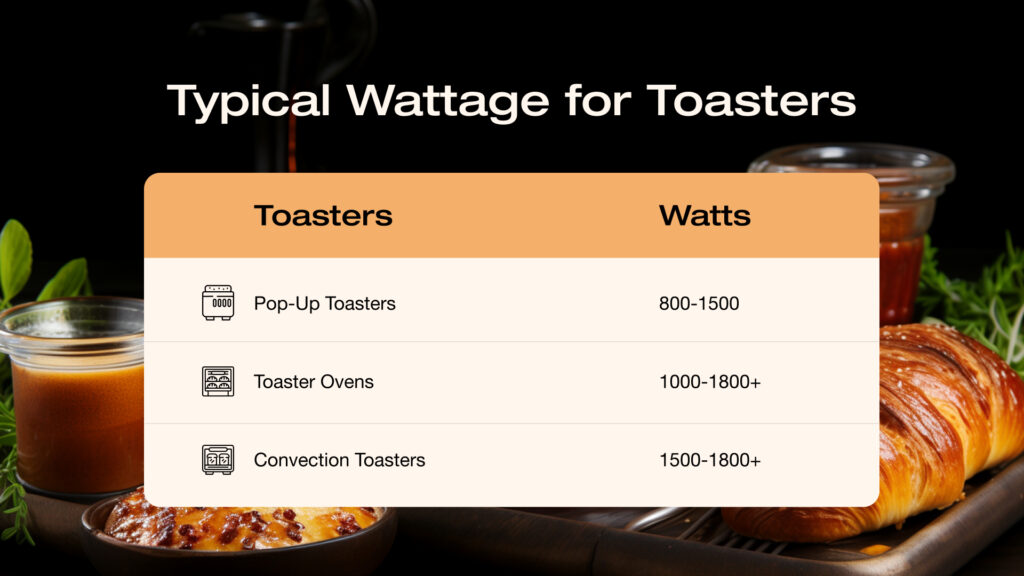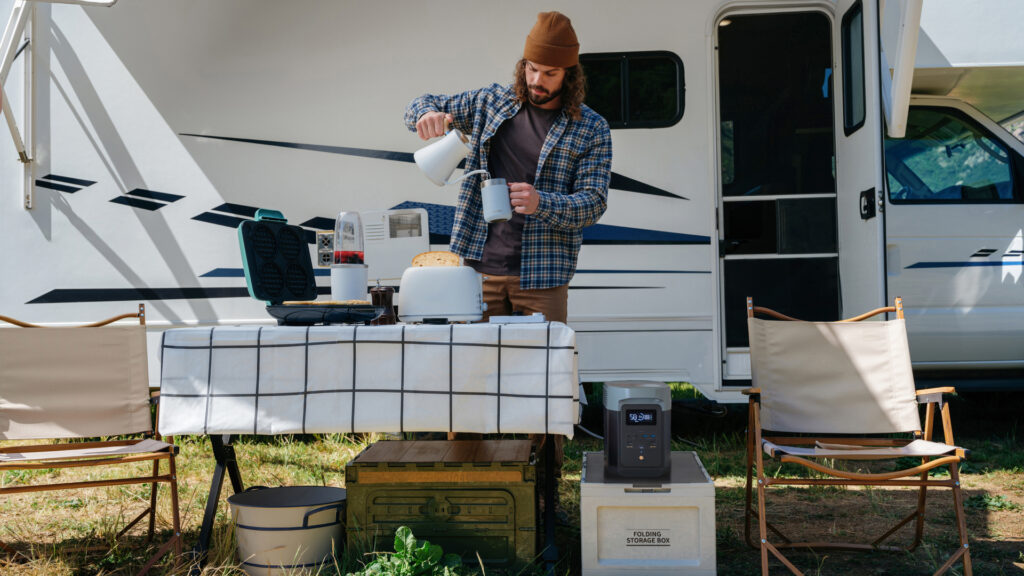- Typical Wattage for Different Types of Toasters
- Factors That Affect a Toaster’s Power Use
- Size and Slice Capacity
- How to Evaluate Your Power Needs
- Consider EcoFlow DELTA 2 for Off-Grid Power
- Reviews of Efficient Toaster Models
- Conclusion and Recommendations
- Frequently Asked Questions
- Do more toasting slots use more electricity?
Toaster Power Trap: How To Find The Perfect Model For Your Home
- Typical Wattage for Different Types of Toasters
- Factors That Affect a Toaster’s Power Use
- Size and Slice Capacity
- How to Evaluate Your Power Needs
- Consider EcoFlow DELTA 2 for Off-Grid Power
- Reviews of Efficient Toaster Models
- Conclusion and Recommendations
- Frequently Asked Questions
- Do more toasting slots use more electricity?
Toasters are a kitchen staple in most homes, but did you know these small appliances can use a surprising amount of electricity? The average toaster ranges from 800-1500 watts depending on the type and features. With Americans using their toasters over 3 billion times per year, all that toast can add up to your energy bill!
In this article, we’ll cover how much power different kinds of toasters use and what factors affect it. You’ll learn how to evaluate your needs and find an energy-efficient toaster that’s just right for your household. We’ll also review some top-rated low-wattage models in different categories. Let’s shed some light on the toaster power trap and find the perfect fit for you!
Typical Wattage for Different Types of Toasters
There are three main types of toasters, each with a range of typical wattages:
Pop-Up Toasters
The classic pop-up toaster with slots is the most common type you’ll find. These typically range from 800-1500 watts.Basic 2-slice models are on the lower end while 4-slice and commercial-style toasters need more power.
Toaster Ovens
Toaster ovens are small countertop ovens with toast slots built in. They have more capabilities than pop-up toasters, but use more electricity – usually 1000-1800+ watts.Larger capacity ovens with convection fans use even more power.
Convection Toasters
Higher-end convection toasters have built-in fans to circulate hot air and toast more evenly. The fan requires extra power, so these models can use 1500-1800+ watts. They take up more counter space as well.
As you can see, wattages cover a wide range depending on features and capacity. So what makes some toasters use more electricity than others?


Factors That Affect a Toaster’s Power Use
Several key factors determine how many watts a toaster will draw, and understanding them can help you make a more informed choice when shopping for an energy - efficient model.
Number and Type of Heating Elements
The number of heating elements in a toaster plays a crucial role in its power consumption. More heating elements typically mean that the toaster can accommodate multiple slots or offer additional functions, such as toasting different types of bread simultaneously or having a wider range of browning settings. However, this convenience comes at the cost of increased power usage.
In terms of the type of heating elements, quartz elements are known for their energy - efficient properties. They require less wattage to generate the same amount of heat compared to metal alloy elements. Metal alloy elements, while durable and common in many toaster models, tend to consume more power to achieve the desired level of toasting. This difference in wattage requirements can have a significant impact on your electricity bill over time, especially if you use your toaster frequently.
Extra Features Like Convection or Broilers
Toasters equipped with extra features like fans for convection cooking or broiler functions consume additional electricity. Convection, which involves circulating hot air around the food, can add a few hundred watts to the toaster's power draw. This feature is designed to ensure more even toasting and can sometimes reduce the overall toasting time, but it comes with a higher energy cost.
Broiler functions, on the other hand, are often used for tasks like lightly browning or melting cheese on top of bagels or other items. These functions typically involve additional heating elements or a different heating configuration, which also contributes to higher power consumption. While these extra features can enhance the versatility of your toaster, it's important to consider whether you'll actually use them frequently enough to justify the extra energy usage.
Size and Slice Capacity
The size of the toaster slots and its overall slice capacity also influence power usage. In general, larger slots and higher - capacity ovens need more wattage to heat efficiently. A toaster designed to handle thick slices of artisanal bread or accommodate multiple slices at once will require more power to reach and maintain the optimal toasting temperature.
However, it's important to note that "bigger isn't always better" when it comes to energy efficiency. If you typically only toast one or two standard slices of bread at a time, investing in a large, high - capacity toaster might result in unnecessary energy consumption.
Considering these design factors will help narrow your search when selecting an energy - efficient model. It's essential to prioritize what features you really need versus what you might simply want, as this can make a significant difference in both the performance and energy consumption of your toaster.
How to Evaluate Your Power Needs
When it comes to choosing the right toaster for your home, several considerations can help you make an informed decision. Here are some key factors to take into account:
Household Size and Usage
The number of people regularly using the toaster is a significant determinant. If you're a single individual or a couple who only toast bread occasionally, a basic, compact toaster with one or two slots might suffice. These models typically consume less power and are more energy - efficient for low - volume usage.
On the other hand, for larger households where multiple family members gather for breakfast every day, a higher - capacity toaster is a must. A toaster with four or even six slots can handle the demand more quickly, reducing the time it takes to prepare everyone's toast. However, keep in mind that larger - capacity toasters generally require more power to operate effectively. This increased power draw is necessary to ensure that all slots heat evenly and toast the bread to the desired level in a reasonable amount of time.
What You’ll Be Toasting
Your choice of toaster also depends on the variety of items you plan to toast. If your toasting routine is limited to standard slices of bread, a simple toaster with basic browning settings will likely meet your needs. These models usually have straightforward heating elements that are optimized for bread and consume a relatively low amount of power.
But if you enjoy toasting a wider range of items such as waffles, bagels, or even small oven - style dishes like toasted sandwiches, you'll need a more versatile toaster. Some toasters come with special settings for bagels, which toast one side more intensely while lightly warming the other. Others may have a broiler function or a wider slot design to accommodate thicker items like waffles. Multi - functional toasters often incorporate additional features like convection fans or more advanced heating elements. While these added capabilities enhance the toaster's versatility, they also increase its power consumption. So, if you do require this level of functionality, it's important to balance your needs with the potential increase in energy usage.
Consider EcoFlow DELTA 2 for Off-Grid Power
For eco-friendly homes that want to cut back on their energy use, the EcoFlow DELTA 2 portable power station is a great off-grid power source for counter appliances like toasters. With its 1,800W AC output and 1,024Wh lithium iron phosphate battery capacity, it can handle any toaster with no problem.
The EcoFlow DELTA 2 has this new X-Boost tech that lets it recharge from 0 to 80% in just 50 minutes. So you’ll never be without your morning toast! And since it’s portable with different power outlets, you can use appliances cord-free anywhere. Getting the EcoFlow DELTA 2 is a smart way to lower your home’s energy consumption, I’d say. The EcoFlow DELTA 2 lets you take power anywhere – like if you go camping or the electricity goes out, you’ll still be able to make toast thanks to the battery and speedy charging. I’d say it’s great for eco-friendly lifestyles and homes trying to cut down on their energy use. So yeah, the EcoFlow DELTA 2 is awesome for off-grid toaster power!
Reviews of Efficient Toaster Models
Now let’s look at some top-rated energy-efficient toaster models in different categories:
Top Low-Wattage Pop-Up Toasters
The Oster 2-Slice Toaster only uses 700W, so it’s a basic pop-up toaster that uses minimal electricity. It has 7 shade settings and options for defrosting, bagels, and canceling toasting, all at a budget price.
The Breville the Bit More has some extra smart features but still only uses 1100W. This roomy 4-slice toaster has an auto-lift function and keep warm feature. It has a bit more power than a standard basic toaster.
Best Value Toaster Ovens
The Panasonic FlashXpress uses 1300W and is compact in size. This versatile toaster oven is great for small households. It saves energy by using quick infrared heating and has presets for toast, pizza, and more.
The Cuisinart Chef’s Convection Toaster Oven uses 1525W. This convection oven efficiently circulates air to cook dishes faster. It has a large 25L capacity but a counter-friendly size.
Eco-Friendly High-End Options
The Dualit Eco Energy Efficiency Toaster uses 30% less energy than normal while still making great toast. Its sleek steel body and replaceable heating elements are designed for efficiency and longevity. Worth the spend if you want an eco-friendly premium toaster!
The Zero Emissions Toaster Oven uses focused infrared heat for 75% more energy savings and nearly zero emissions. It’s pricey but awesome for eco-conscious folks.
Conclusion and Recommendations
Finding an energy-efficient toaster is about balancing your household’s needs with some smart design considerations. Look for the right size and features you actually require – extra capacity and stuff you don’t need can just add unnecessary costs over time. Investing in high-quality models like convection toasters and infrared ovens that save energy is a good move. For an eco-friendly power source, the portable EcoFlow DELTA 2 gives you off-grid power for toasters and any counter appliances.
To make the best choice for your home, take a look at how you’ll use your toaster. Figure out the must-have features versus the nice-to-have extras. With the right research and reviews, you can find energy-saving toaster options perfectly tailored to your lifestyle. Just remember – you can get your dream toast without putting extra strain on your energy bill or the environment!


Frequently Asked Questions
What wattage is best for a 2-person household?
For a smaller 2-person household, a toaster with 1000-1200 watts is ideal. Go for high-quality 2-slice pop-up toasters or compact toaster ovens. The Oster 2-slice and Panasonic FlashXpress are great picks that won’t waste energy.
Do convection toasters use more electricity?
Yep, the internal convection fan needs more power, usually around 1500-1800 watts for convection toasters. But they use energy more efficiently overall by distributing heat evenly with less preheating time.
Can the EcoFlow DELTA 2 power a toaster oven off-grid?
Absolutely! With 1800 watts of continuous AC power from its 1024Wh battery capacity, the EcoFlow DELTA 2 can easily power any pop-up or full-size toaster oven off-grid. It’s a perfect eco-friendly power solution.
Should I look for plastic or metal when buying an energy-efficient toaster?
Metal toasters retain heat better and use less energy once warmed up. However, plastic toasters are safer, better insulated, and weigh less. For maximum efficiency, look for a stainless steel or aluminum-body toaster.
Do more toasting slots use more electricity?
Yes, generally the more slots and functions a toaster has, the more electricity it will require, as there are more heating elements. Prioritize what features you really need based on your household habits.